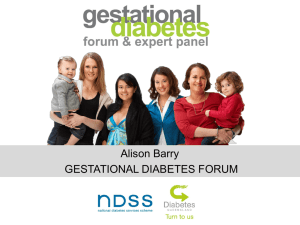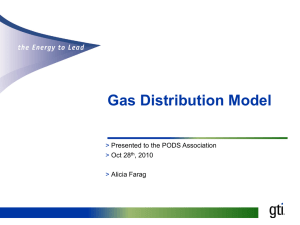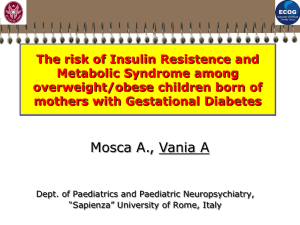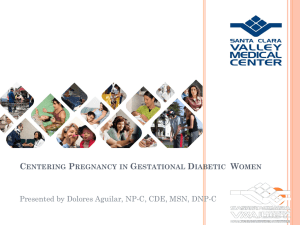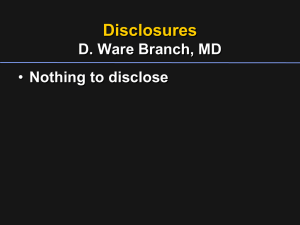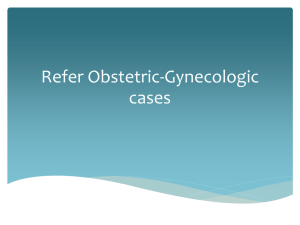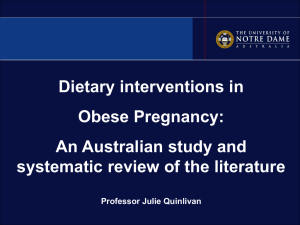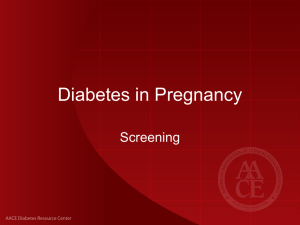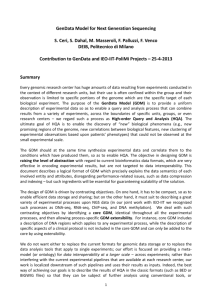2. Routine testing for GDM
advertisement
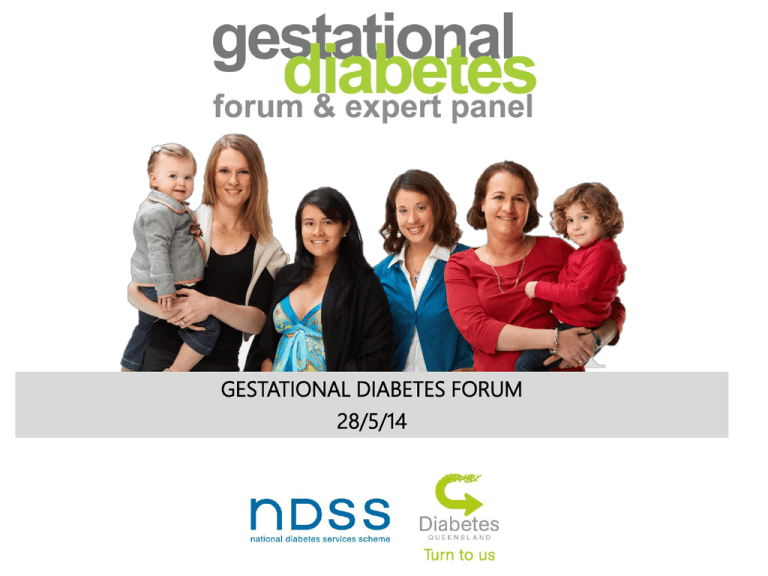
GESTATIONAL DIABETES FORUM 28/5/14 Hyperglycemia in Pregnancy Gestational Diabetes Mellitus • Is GDM important? • How should we screen for it? • Does treatment make a difference? – What are the treatment options? Medical Management of GDM Professor David McIntyre • Approaching 100% consensus regarding diagnosis Australian Consensus • RANZCOG convened consensus conference Nov 1, 2013 • Present: RANZCOG, ADIPS, RCPA, ADS, ADEA, ACM, SOMANZ • Absent: ESA, RACGP • Major recommendations: – Cease GCT July 2014 – Adopt IADPSG / WHO criteria Jan 2015 Australian Consensus • NHMRC guidelines for Antenatal Care – First visit – assess risk of DM (Age, BMI, previous GDM, FH diabetes, PCOS, ethnicity) – Early test for hyperglycemia in women at higher risk – Test (or re – test) at 24 – 28 weeks if not known DM – Use WHO / IADPSG protocol and thresholds Finer points • Exactly who is “high risk”? • Terminology: “Overt Diabetes” (IADPSG) vs. “Diabetes in Pregnancy” (WHO) vs. No specific comment (ADIPS) • Role of HbA1c • Remote areas ? • Intensity of treatment? Evidence for benefit of GDM treatment Treatment of GDM Reduces Adverse Outcomes* Outcome ACHOIS RCT (%) P Not treated Treated BW >90th percentile 22 13 BW < 10th centile 7 7 NICU admission 61 71 0.04 Shoulder Dystocia 3 1 0.08 Preeclampsia 18 12 0.02 *Crowther C et al. NEJM 352: 2005 <0.001 Treatment of GDM Reduces Adverse Outcomes* Outcome NICHD RCT (%) P Not treated Treated BW >90th percentile 14.5 7.1 <0.001 C-peptide >95th percentile 22.8 17.7 0.07 NICU admission 11.6 9.0 0.19 Shoulder Dystocia 4.0 1.5 0.02 Preeclampsia 5.5 2.5 0.02 *Landon MB et al. NEJM 361:1339-48, 2009 Formal cost effectiveness Incremental Cost GDM Cost / QALY Conclusions ACHOIS $US 247 $US 2,186 Cost effective MFMNU $US 456 $US 20,412 Cost effective Likely cost effective at lower glucose levels Study A7:2007 MS et al AJOG MFMNU: Ohno 282: 2011 GDM - what we might like to see The dichotomous dilemma Badness vs. Category 30 25 20 iGDM 15 10 5 Not GDM GDM 0 1 2 3 4 5 iGDM category 6 7 What we actually see – HAPO AJOG 2010 Hyperglycemia & adverse pregnancy outcome study Study showed that mild elevations of BGL associated with adverse pregnancy outcomes Shades of Grey GDM screening tests: One Step versus Two Step Process with a Glucose Challenge Test • GCT lacks both sensitivity and specificity – Leeuwen BJOG 2012 – Systematic review of all studies with both GCT and OGTT in all women – Overall sensitivity for GDM diagnosis on OGTT ~0.74 • Issues – – – – 25 % GDM missed with GCT Need to return for OGTT if GCT positive Loss of follow up Diagnosis and therapy delayed Van Leeuwen et al. (BJOG 2012;119:393–401) ADIPS GDM diagnostic criteria - 2013 1. Early testing for GDM with risk factors 1. 2. “Moderate risk factors” for GDM screened with either a random or a fasting glucose test followed by a pregnancy OGTT (POGTT) if clinically indicated “High risk” of GDM (one high RF or two moderate RF) should undergo a 75 g POGTT ADIPS GDM diagnostic criteria - 2013 Moderate Risk factors • Ethnicity: Asian, Indian subcontinent, Aboriginal, Torres Strait Islander, Pacific, Islander, Maori, Middle Eastern, non‐white African • BMI 25 – 35 kg/m2 High Risk factors • • • • • • • • Previous GDM Previously elevated BGL Maternal age ≥40 years Family history DM (1st degree relative with DM or a sister with GDM) BMI > 35 kg/m2 Previous macrosomia (baby with birth weight > 4500 g or > 90th centile) PCOS Medications: corticosteroids, antipsychotics ADIPS GDM diagnostic criteria - 2013 2. Routine testing for GDM • All women should have an 75 gm fasting POGTT at 24-28 weeks • Diagnosis of GDM ( Recommended by RANZCOG to be adopted by Jan 2015) – one or more of the following glucose levels are elevated; • Fasting glucose ≥ 5.1mmol/L • 1‐hr glucose ≥ 10.0mmol/L • 2‐hr glucose ≥ 8.5mmol/L IADPSG vs. 1991 ‘Ad hoc’ / ADIPS Measure Fasting VPG 1 hr VPG 2 hr VPG Value (mmol/L) ADIPS (mmol/L) ≥ 5.1 5.5 ≥ 10.0 ≥ 8.5 N/A 8.0 Tsunami of GDM? Australian Data - Population • Compared to ADIPS criteria, using 1275 women from Wollongong Measure Public GDM Private GDM Overall GDM % Abnormal IADPSG 9.1 % Abnormal ADIPS 8.6 16.2 13.0 10.5 9.6 Moses R et al MJA 2011: 194 Contemporary MMH cohort (n=2017) GDM by Criteria Normal IADPSG Only Ad hoc Only Both 2% 6% 3% 89% GDM ; Management - Multidisciplinary • • • • • Dietician & Diabetes educator review Home Blood glucose monitoring – qid, fasting and 2 hour post prandial Lifestyle changes – diet and physical activity AN care continued in collaboration with midwives/obstetricians BGL Targets - little firm evidence regarding BG targets Current targets • - Fasting <5.5mmol/L - 1hr post prandial <8.0 mmol/L - 2 hr post prandial <7 mmol/L (<5.1 mmol/L) (< 7.4 mml/L) (<6.7 mmol/L) Suggested BG treatment targets based on 2SDs above the mean values for pregnant women without known risk factors. Treatment options Insulin or metformin ( in some centres) if failing to meet glucose targets Individualize Rx - fetal growth! Glycemia in normal pregnancy (gestational week 33.8 ± 2.3) across 11 studies published between 1975 and 2008. Mean + 1 SD: Fasting 4.4 mmol/L 1 hour 6.8 mmol/L 2 hour 6.1 mmol/L Mean + 2 SD: Fasting 4.8 mmol/L 1 hour 7.5 mmol/L 2 hour 6.6 mmol/L Hernandez T L et al. Dia Care 2011;34:1660-1668 Copyright © 2011 American Diabetes Association, Inc. Recommended targets Fasting mmol/L 1 hour PP mmol/L 2 hours PP mmol/L Old ADIPS 5.5 8.0 7.0 New ADIPS 5.0 7.4 6.7 USA 5.3 Mean + 1 SD* 4.4 6.8 6.1 Mean + 2 SD* 4.8 7.5 6.6 * from:- Hernandez et al D Care, 2011 6.7 Medication use • “Lifestyle” for all • ? Availability of extra resources (e.g. dieticians / diabetes educators / exercise physiologists) • Medication use – ACHOIS 20%, US MFMNU trial 10% (insulin) – MMH clinic 35 – 40 % (insulin + metformin) • Accuracy of home glucose meters in the GDM range Models of care • • • • • • Variable around Australia Groups vs. Individual RCT models of care vs. resources and reality Fetal monitoring GP based care Risk stratification Supporting clinical care • • • • Use of IT – meters / decision support tools Telehealth to support isolated areas Educational packages Structure for post natal / inter pregnancy care – Link to mother and baby health checks Metformin vs. Insulin • Women entitled to explanation and choice of therapy • Immediate pregnancy outcomes with metformin comparable to insulin therapy • No suggestion teratogenicity • Convenience of treatment • Longer term outcomes for children. Metformin vs. Insulin • Metformin – Not quite as easy as it seems – GIT side effects may be troublesome – Officially “Category C” in Australia – Risk of “dumbing down” of high risk pregnancy care – Push to use metformin economic rather than clinical Postnatal care of women with GDM • Recommendations: – 75 gr 2 hr OGTT 6-12 weeks postpartum to exclude diabetes – Follow up OGTT two yearly (possibly at time of cervical screening) or yearly if planning another pregnancy – Repeat OGTT early in subsequent pregnancy – Lower risk women consider fasting PG every 1-2 years – Follow up of impaired fasting glucose by regular checks for frank diabetes in addition to assessment of other risk factors of macrovascular disease Other important issues • Long term maternal health and opportunities for prevention – Risk of diabetes – 70 % lifetime risk of developing T2 DM – Risk of cardiovascular disease • Long term health of children – increased risk Obesity and IGT • Intergenerational transmission of diabetes and other risks Heaven / Nirvana of Diabetes Prevention Population / Environment measures Pre conception testing Higher risk Early pregnancy testing Higher risk “Standard” GDM testing Higher risk Repercussions PERSONAL – Where we draw the line does matter Non - GDM Pregnancy Maternal Health Baby Health GDM Pregnancy Maternal Health Baby Health
